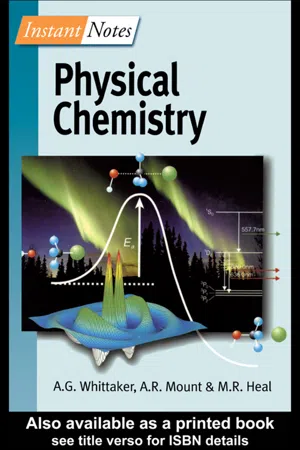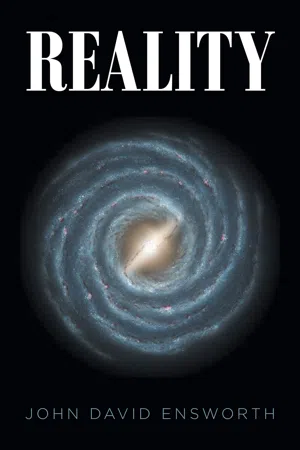Chemistry
Entropy
Entropy is a measure of the disorder or randomness in a system. In chemistry, it is associated with the dispersal of energy and the number of ways a system can be arranged. An increase in entropy indicates a spontaneous process, while a decrease in entropy requires an input of energy.
Written by Perlego with AI-assistance
6 Key excerpts on "Entropy"
Learn about this page
Index pages curate the most relevant extracts from our library of academic textbooks. They’ve been created using an in-house natural language model (NLM), each adding context and meaning to key research topics.
- eBook - ePub
- Dov M. Gabbay, Paul Thagard, John Woods(Authors)
- 2011(Publication Date)
- North Holland(Publisher)
Entropy in ChemistryRobert J. Deltete
1. Introduction
Contemporary textbooks in physical chemistry and chemical thermodynamics regularly refer to the importance of the concept of Entropy in describing the course of chemical reactions and the conditions for chemical equilibrium (e.g., [Winn, 1995 , p. 63]). This was not always the case. In fact, for the most part, it was quite the opposite for a long time, enough so that two recent authors could subtitle a paper “the tortuous entry of Entropy into chemistry” [Kragh and Weininger, 1996 ]. In this essay, I begin in Section II with a brief description of the entry of Entropy into physics through the work of Rudolf Clausius. I then sketch, in Sections III and IV, the productive use to which the concept was put in the work of Josiah Willard Gibbs and Max Planck, before turning in Section V to the reasons that most chemists did not follow Gibbs and Planck. Section VI offers some speculations on how resistance to Entropy on the part of chemists was gradually overcome.2. Clausius on Entropy
The essential step leading to the concept of Entropy was taken by Clausius in 1850, when he argued that two laws are needed to reconcile Carnot's principle about the motive power of heat with the law of energy transformation and conservation. Efforts to understand the second of the two laws finally led him in 1865 to his most concise and ultimately most fruitful analytical formulation. In effect, two basic quantities, internal energy and Entropy, are defined by the two laws of thermodynamics. The internal energy U is that function of the state of the system whose differential is given by the equation expressing the first law,1(1)where đQ and đW are, respectively, the heat added to the system and the external work done on the system in an infinitesimal process. 1 For a simple fluid, the work is given by the equation - eBook - ePub
Biomolecular Thermodynamics
From Theory to Application
- Douglas Barrick(Author)
- 2017(Publication Date)
- CRC Press(Publisher)
including the entire universe . These concepts give rise to another statement of the second law:The Entropy of an isolated system (the universe) increases during any spontaneous process.Here, “spontaneous” is synonymous with irreversible. Since all processes that occur in isolation (i.e., without an external driving force) must be spontaneous, this means that all natural processes increase Entropy. Although reversible processes do not increase Entropy, they do not decrease it. Rather, the second law states that process that decrease Entropy do not occur in isolation.‡Passage contains an image Entropy As a Thermodynamic Potential
A key feature of the inequality developed in the previous section is that it makes the Entropy into a thermodynamic potential. By potential, we mean that when an isolated system is away from equilibrium, Entropy identifies the direction of spontaneous change and provides a driving force for change. Moreover, as a potential, Entropy locates the position of equilibrium. Identifying the position of equilibrium is extremely important in analyzing the thermodynamics of chemical reactions.Though readers may be unfamiliar with the concept of a thermodynamic potential, everyone is familiar with potentials associated with simple mechanical systems with just a few degrees of freedom. For a ball on a hill, gravity provides a potential, determining which direction the ball will move (downhill), and where it will come to rest (an equilibrium position, at the bottom of the hill). Both pieces of information can be quantified by taking derivatives, and for the equilibrium position, using the derivative to find a minimum.Potential energy is also important on the molecular scale for determining favorable bonding patterns, and these interactions clearly influence bulk equilibrium properties of a system of molecules. However, translating all this molecular information into a bulk potential is difficult for simple systems, and is impossible for complicated systems. The beauty of the classical Entropy is that it ignores all the molecular detail. It acts as a potential for the bulk properties of a system, implicitly averaging over these important (but often inaccessible) molecular details. - eBook - ePub
- Gavin Whittaker, Andy Mount, Matthew Heal(Authors)
- 2000(Publication Date)
- Taylor & Francis(Publisher)
The Entropy of an isolated system increases for irreversible processes and remains constant in the course of reversible processes. The Entropy of an isolated system never decreases’.The second law of thermodynamics may be expressed in a large number of ways, but all definitions are equivalent to the one given here. The statistical definition of Entropy helps visualization of the second law. As all spontaneous changes take place in such a way as to increase the total Entropy, it follows that they proceed so as to engineer the chaotic (rather than ordered) dispersal of matter and energy:The ‘>’ relation applies to irreversible processes, and the ‘=’ relation applies to reversible processes (see Topic ). It is important to appreciate that the second law of thermodynamics as expressed above refers to an isolated system. Most experimental systems cannot be regarded as being isolated, in which case the universe, being the next largest container of our system, effectively becomes the isolated system. In this case, the total Entropy change is simply the sum of the Entropy change in the system and in the surroundings, and this total must be greater than or equal to zero to comply with the second law of thermodynamics:For instance, the system Entropy change in the reaction between hydrogen and fluorine gases to generate liquid hydrogen fluoride is found to be −210 J K-1 mol-1 . Although this represents a decrease in Entropy, the reaction proceeds spontaneously because the total Entropy change is greater than zero. The positive Entropy change arises because the reaction is exothermic, and the heat lost to the surroundings causes ΔS surroundings to be positive, and of greater magnitude than ΔS system .Standard Entropy change
Any non-equilibrium process leads to a change in Entropy . As Entropy is a state function - eBook - ePub
- John David Ensworth(Author)
- 2021(Publication Date)
- Covenant Books, Inc.(Publisher)
reality . I touched on it above but let me state first that Entropy is also a measure of the randomness of a system (also called disorder). Entropy or randomness is also the lack of predictability of a system’s state in the future. We will expand on the concept of randomness greatly in section 3, chapter 12 (postulate 3c).The Arrow of TimeEntropy (which is also the increase in information in a system over time and the increase in disorder and randomness over time) is also credited for possibly solving one of the longer standing problems in physics called the arrow of time (note: not every physicist is convinced of this but it is a majority opinion in the field at present).The tent-pole physical theories of general relativity (which contains within it the older Newtonian approach to physics with important improvements like no longer assuming the velocity of all objects of interest are really close to zero or that the speed of light is infinite) and quantum mechanics (QM—touted as the most successful theory created by humankind in that it has even predicted the existence of completely unobserved particles, like the Higgs Boson, forty years before the technology existed that could detect it) have a problem. The equations of QM and relativity contain time, but the sign of time doesn’t matter. You can plug in 45 seconds or -45 seconds and you get accurate results about an event described by the mathematics of general relativity. The sign of time doesn’t matter. You can bounce protons or electrons off each other or have two particles create a new one or a single particle decay into two particles with a forward flow of time or a backward flow of time and the physics still works. - eBook - ePub
- Wolfgang Hofkirchner, Wolfgang Hofkirchner(Authors)
- 2013(Publication Date)
- Routledge(Publisher)
c. The third law is true by definition, for a perfectly ordered state at absolute zero there is no missing information.”In 1872 Boltzmann defined Entropy in terms of possible microstates2.3 Statistical EntropyS = k log W(4)where W is the so called thermodynamic probability, or the number of microstate referring to the same macrostate. The modern formulation is:S = k ∑(5)pιlnpιwherepιis the probability of the microstate i . It was shown, that the two entropies are equivalent.The information theory—statistical Entropy link was elaborated by Jaynes [57], who pointed out, that this probabilistic Entropy expression has two interpretations, namely: we have to define the probabilities first and thereby the Entropy. The other way is considering S as the measure of uncertainty and defining the values of probability through the principle of minimum prejudice:That Entropy maximum principle found a wide scope of application. The mathematical theory and application of Entropy see in Rényi [71].“Assign the set of probabilities which maximizes the Entropy and is in agreement with what is known.” [Tribus, 87]There are several approaches to make the relation between Entropy and information, namely the order–disorder metaphor, negEntropy and we discuss the extropy approach.3 INFORMATION AND Entropy— PHYSICAL INFORMATION3.1 Order–DisorderThe increase of Entropy means that in natural processes the system tends to occupy more and more probable states; states with higher number of microstates. Generally the smaller is the number of the microstates the more ordered is the system. That is the base of the Entropy—disorder metaphor. It is a very fruitful metaphor. But it is only a metaphor. [O’Connor, 94] On one hand the Entropy is a well defined physical quantity, on the other hand the order–disorder is a subjective category. The same system can be ordered for one person and simultaneously disordered for the other. I learnt it from my son. Once I made order in his room. When he saw it, he came to me: Mama, look! There is a terrible tragedy. Somebody disordered my toys. - eBook - ePub
Bioenergetics
A Bridge Across Life and Universe
- Davor Juretic(Author)
- 2021(Publication Date)
- CRC Press(Publisher)
Seifert 2012 ). Regarding life-origin proposals, it is not credible that considerably simpler molecular machines for harnessing free-energy gradients in the origin-of-life period were more efficient than their present-day relatives. Much more likely situation then was that the ratio of wasted to used energy for any organic synthesis was considerably higher in that period.Thus, we must return to the same question why dissipation was crucial for the emergence of life as it is essential in the present-day bioenergetics? Is it possible that Entropy production had some role in selecting the organic structures capable of increasing Entropy production? The assumption underlying this question about the capability of far-from-equilibrium systems to facilitate Entropy production increase in the universe opens the issue that is clearly in the realm of physics: why should the universe care about any local increase in the dissipation level? The dissipation rate cannot be the consequence of the Second Law of Thermodynamics Unfortunately, the Second Law does not say anything about how fast the system approaches the thermodynamic equilibrium.The evolution of all physical systems is coupled to the decrease of their free energy in the least time (Wang 2006 , Lucia 2014 ). Thermodynamics is the only branch of classical physics concerned with evolution. It does not distinguish between animate and inanimate systems. The physical principle of maximum energy dispersal is equivalent to the maximal rate of Entropy production with no demarcation lines to its application between animate and inanimate, incipient life, or developed living systems (Kaila and Annila 2008 , Annila and Salthe 2010 , Annila and Kolehmainen 2015 ). The origin of life must involve the dissipation of energy (Pascal et al. 2013) even to the extent that living systems should be regarded as manifestations of physical principles about dissipation intensity rather than ends in themselves (Annila and Baverstock 2014 ). Thus, the consideration of the physical tenets relevant for the origin of life gives the advantage to “metabolism-first” (Morowitz 2004 , Anet 2004 , Russel 2018) rather than the “replication-first” (Joyce 2002 , Orgel 2004 , Müller 2006





